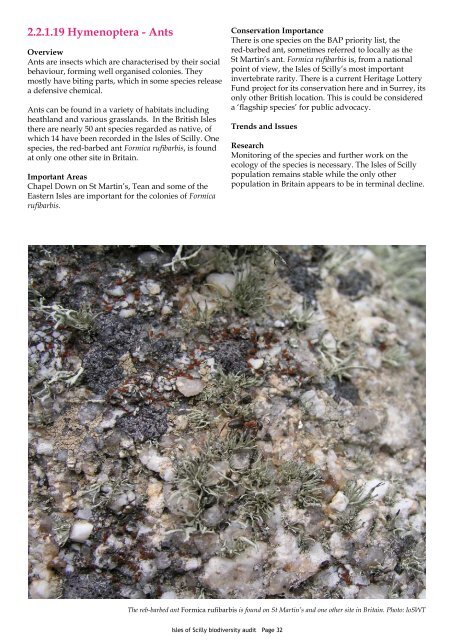The Isles of Scilly Biodiversity Audit 2008 - Cornwall Wildlife Trust
The Isles of Scilly Biodiversity Audit 2008 - Cornwall Wildlife Trust
The Isles of Scilly Biodiversity Audit 2008 - Cornwall Wildlife Trust
You also want an ePaper? Increase the reach of your titles
YUMPU automatically turns print PDFs into web optimized ePapers that Google loves.
2.2.1.19 Hymenoptera - AntsOverviewAnts are insects which are characterised by their socialbehaviour, forming well organised colonies. <strong>The</strong>ymostly have biting parts, which in some species releasea defensive chemical.Ants can be found in a variety <strong>of</strong> habitats includingheathland and various grasslands. In the British <strong>Isles</strong>there are nearly 50 ant species regarded as native, <strong>of</strong>which 14 have been recorded in the <strong>Isles</strong> <strong>of</strong> <strong>Scilly</strong>. Onespecies, the red-barbed ant Formica rufibarbis, is foundat only one other site in Britain.Important AreasChapel Down on St Martin’s, Tean and some <strong>of</strong> theEastern <strong>Isles</strong> are important for the colonies <strong>of</strong> Formicarufibarbis.Conservation Importance<strong>The</strong>re is one species on the BAP priority list, thered-barbed ant, sometimes referred to locally as theSt Martin’s ant. Formica rufibarbis is, from a nationalpoint <strong>of</strong> view, the <strong>Isles</strong> <strong>of</strong> <strong>Scilly</strong>’s most importantinvertebrate rarity. <strong>The</strong>re is a current Heritage LotteryFund project for its conservation here and in Surrey, itsonly other British location. This is could be considereda ‘flagship species’ for public advocacy.Trends and IssuesResearchMonitoring <strong>of</strong> the species and further work on theecology <strong>of</strong> the species is necessary. <strong>The</strong> <strong>Isles</strong> <strong>of</strong> <strong>Scilly</strong>population remains stable while the only otherpopulation in Britain appears to be in terminal decline.<strong>The</strong> reb-barbed ant Formica rufibarbis is found on St Martin’s and one other site in Britain. Photo: IoSWT<strong>Isles</strong> <strong>of</strong> <strong>Scilly</strong> biodiversity audit Page 32
















